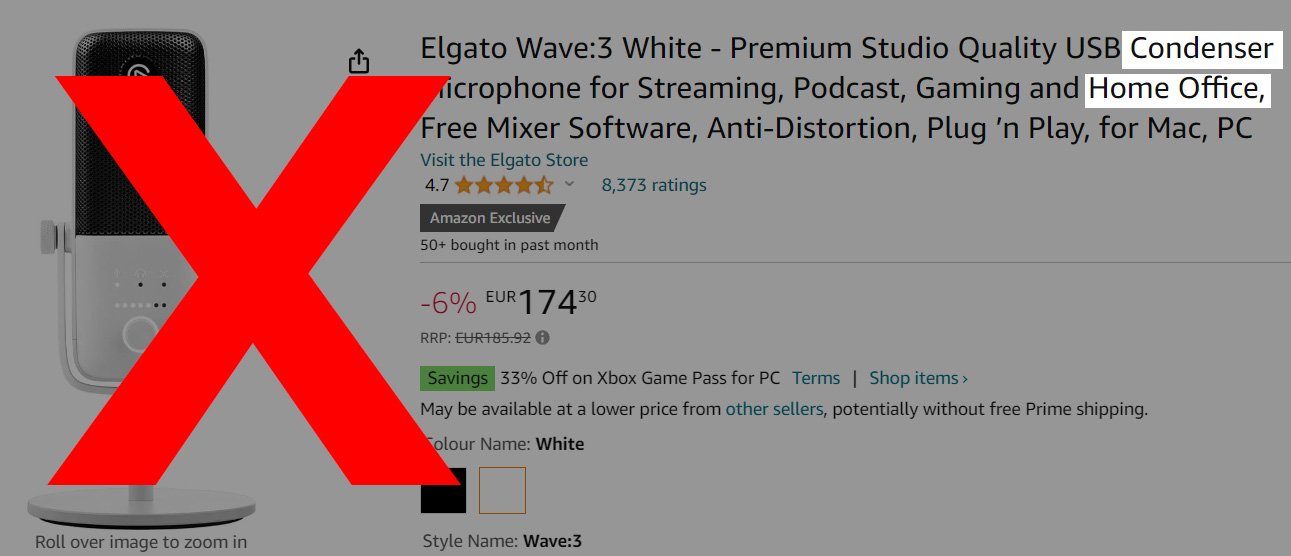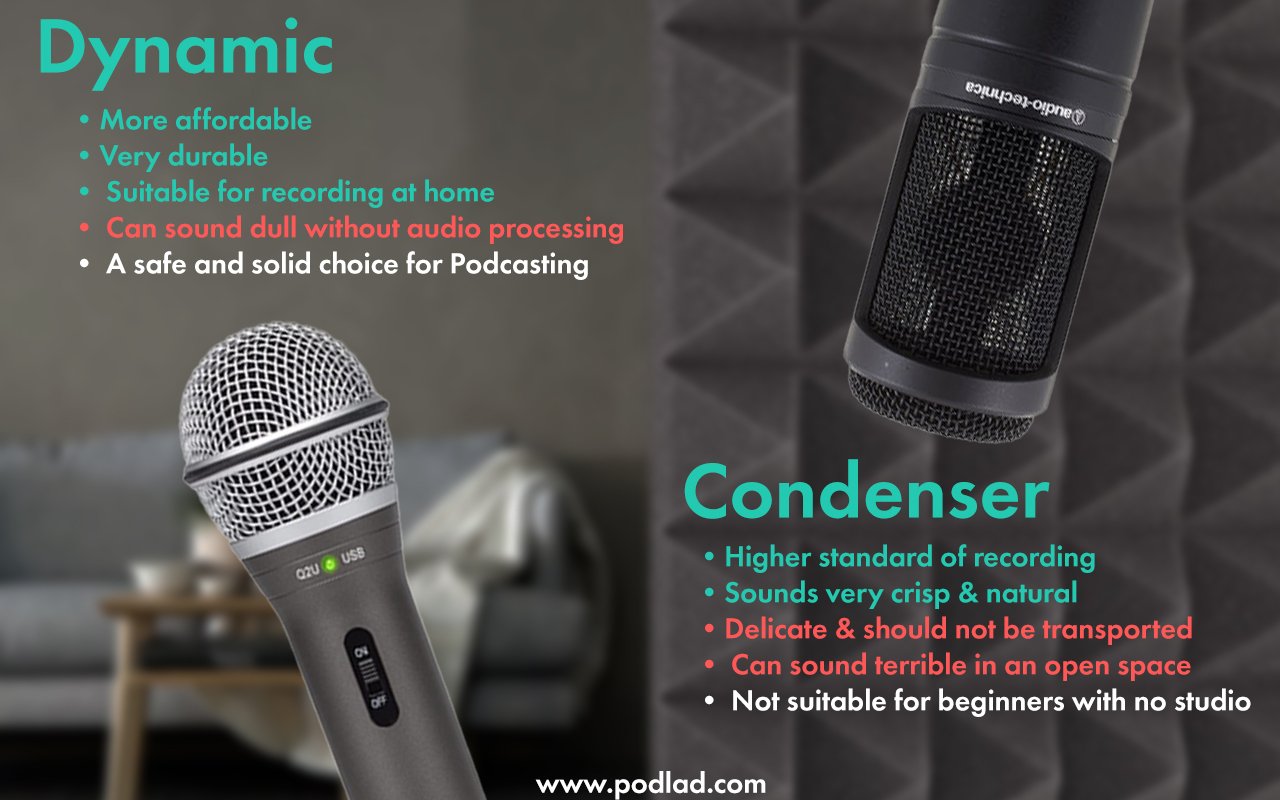Dynamic vs Condenser mics: which is best for Podcasting - a non-technical guide
The dynamic vs condenser mics can be confusing and daunting for podcasters who don’t know or care about the technicals of microphones. It’s hard to know what to look for in a Podcast microphone, so I will try and make it as simple as possible.
In a nutshell, dynamic and condenser are 2 different ways in which microphones are built. Unfortunately, I have seen a huge amount of podcasters make the wrong choice when picking their microphone for recording a podcast. Follow the advice below and you won’t go wrong.
Some Podcasts that follow our guidance on microphones and recording:
Dynamic vs Condenser mics, how to spot the difference
Dynamic mics (pictured right) look more like what you’d probably consider a classic mic.
Dynamic mics are always used outside a soundproofed studio environment. For example live music performances, outdoor reporting or in any wide-open space.
The reason they work so well outside of a studio is that they pick up the area closest to the microphone and reject a lot of everything else happening around them. This makes them more versatile (or more dynamic, if you will).
Condenser mics (pictured left) are larger in size. You can usually see the circular diaphragm behind the screen.
They are delicate and pick up a large range of frequencies giving a crystal clear sound if used in a space that has a completely dead sound (such as a recording booth).
In the correct environment of a studio, they sound amazing. This is why they are used for professional vocal recordings.
Why Condenser mics are not a safe choice for Podcasts
Be warned, condenser microphones can be problematic and here’s something very important to remember: Condenser mics are NOT suitable for recording in a home office. Despite this, they are often wrongly marketed as being the right mic choice:
The location is the most important thing to consider when choosing between a dynamic vs condenser microphone. What type of room or location are you recording a podcast in?
Condenser microphones are excellent. They give a clear and crisp sound and can make your voice sound tremendous BUT, only in a suitable space!
Condenser microphones are delicate and sensitive. They pick up an extensive range of frequency sounds. So, they should only be used in a space protected from noise, space, and sound reflections. In a nutshell, they are designed for use in a soundproofed recording booth.
Condenser mics can be very unforgiving. If used in a standard living room or bedroom, condenser microphones can give you a lot of background noise and make your recording sound very spacious.
What if you want 2 speakers in a room? Suddenly condensers become problematic again as 2 of them in 1 room are so sensitive that they begin to pick each other up and cause awful background noise and feedback problems.
Dynamic vs Condenser, which is right for your Podcast?
For the vast majority of podcasters, dynamic microphones are the better choice. The reality is that most DIY podcasters record from home they don’t have the space or budget to pay for a studio or soundproof a room in their home.
I have lost count of the podcasters I have encountered who have purchased condenser microphones as they were told they were “the best podcast mic” or because they look impressive. Yes, they are technically the best you can get, but they can sound echoey and distant if used somewhere that isn’t a recording booth.
Don’t overspend on a condenser microphone; don’t get one because it looks glamorous or you’ve read it’s the highest standard available.
Mic test playback of Dynamic and Condenser mics
The easiest way to compare is to do some mic test playback with some of the best and most affordable dynamic and condenser microphones on the market.
I am using USB mics only, which are the most user-friendly and cheapest to set up at home. All are mics I like, but take a listen and see if you can notice the difference in sound quality, remember to take the price into consideration. Does the quality difference warrant the price?
Condenser: Rode NT-USB Microphone - approx €150
Condenser: Audio Technica AT2020 - approx €120
Dynamic vs Condenser: the decision
In the VAST majority of scenarios, a dynamic mic is the best option for podcasting.
The only negative I can think of with a Dynamic mic is that it can give a slightly dull sound if you don’t treat the audio. If you use a Podcast editor or know how to process audio, this won’t be a problem as a touch of EQ and compression can make them sound a lot sharper.
Consider these points when deciding what is the best podcast microphone for you:
You record in an untreated room or in a “home studio” - Dynamic.
You want a cheaper, more durable microphone - Dynamic
You want to ability to bring your microphone to different locations - Dynamic
You record in a room with multiple mics/speakers - Dynamic
You record on your own in a small space, which has sound treatment or soft walls and floors - Condenser (however a dynamic would also suit this scenario)
My Podcast mic winner: Dynamic
The main benefit of a condenser mic is its pristine level of sound quality. This is why they are used at the highest level of audio recordings, such as voiceovers and singing.
However, the difference in standard is not noticeable enough on an mp3 podcast recording to warrant the extra money it will cost you.
That, on top of the fact that it can sound poor in the wrong environment, leaves us with a crystal clear winner.
My advice on this is pretty straightforward, the winner of dynamic vs condenser mics for a podcast is to go dynamic. You will never go wrong with a dynamic mic for podcasting.
Recommended best dynamic mics for Podcasting:
Both suggestions are USB to allow for easy plug-and-go when starting a podcast. They are also available on Amazon at a very reasonable price:
Samson Q2U (USB making it easier for beginners)
Shure SM58 (needs an audio interface + xlr cable)
You now have the right microphone for podcasting. However, you should learn a little about microphone technique and how to use the microphone properly to get a professional sound.
Best software to record with a dynamic mic
You have selected the best mic for your room and learned how to use it correctly. The final step is choosing software to record with. If recording a remote podcast, you should avoid using Zoom as, by default, it degrades audio quality.
The easiest solution for the vast majority of Podcasters is Riverside.fm
This platform captures audio at the source, so the quality is the same as if you were recording direct into digital audio software like Pro Tools or Adobe Audition.
The free plan allows up to 2 hours of free recording time, perfect for beginners.
It works through a browser, so there is no downloading involved. It also stores all audio and video on a cloud, so if you use an editor, you won’t need to download/upload any files for them.







